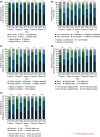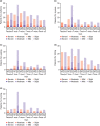Clindamycin phosphate 1.2%/benzoyl peroxide 3% fixed-dose combination gel versus topical combination therapy of adapalene 0.1% gel and clindamycin phosphate 1.2% gel in the treatment of acne vulgaris in Japanese patients: A multicenter, randomized, investigator-blind, parallel-group study
- PMID: 29905384
- PMCID: PMC6099304
- DOI: 10.1111/1346-8138.14497
Clindamycin phosphate 1.2%/benzoyl peroxide 3% fixed-dose combination gel versus topical combination therapy of adapalene 0.1% gel and clindamycin phosphate 1.2% gel in the treatment of acne vulgaris in Japanese patients: A multicenter, randomized, investigator-blind, parallel-group study
Abstract
Adapalene 0.1% (ADA) with clindamycin phosphate 1.2% (CLNP; ADA + CLNP) and the fixed-dose combination containing CLNP and benzoyl peroxide 3% (CLNP/BPO 3%) are strongly recommended for the early treatment of acne vulgaris in Japan. Here, we compare the early efficacy and safety of CLNP/BPO 3% with Japanese standard topical use of ADA + CLNP in the treatment of acne vulgaris. In this phase IV, multicenter study, 351 patients were randomized to receive CLNP/BPO 3% or ADA + CLNP for 12 weeks. The primary end-point was percentage change from baseline in total lesion (TL) counts at week 2. Secondary end-points included the percentage change from baseline in TL, inflammatory and non-inflammatory lesion (IL and non-IL) counts, Investigator's Static Global Assessment (ISGA), quality of life (QoL [Skindex-16]) and patient preference. Local tolerability scores and adverse events were also recorded. CLNP/BPO 3% provided a significantly greater percentage reduction from baseline in TL compared with ADA + CLNP at week 2, and week 4. Compared with ADA + CLNP, CLNP/BPO 3% was superior at reducing IL (but not non-IL) over weeks 2-12, was more effective at improving patient QoL and ISGA, and scored higher in patient-preference assessments. Both treatments were well tolerated; adverse drug reactions occurred more frequently in patients receiving ADA + CLNP (37%) than in those receiving CLNP/BPO 3% (17%). In conclusion, CLNP/BPO 3% showed greater efficacy for the early treatment of acne vulgaris in Japan, with a more favorable safety profile compared with ADA + CLNP.
Keywords: acne vulgaris; adapalene; benzoyl peroxide; clindamycin; drug combinations.
© 2018 The Authors. The Journal of Dermatology published by John Wiley & Sons Australia, Ltd on behalf of Japanese Dermatological Association.
Figures






Similar articles
-
Comparative efficacy of clindamycin phosphate with benzoyl peroxide versus clindamycin phosphate with adapalene in acne vulgaris: a systematic review and meta-analysis.Sci Rep. 2025 Jul 1;15(1):20478. doi: 10.1038/s41598-025-05543-7. Sci Rep. 2025. PMID: 40594517 Free PMC article.
-
Safety and efficacy of clindamycin phosphate 1.2%-benzoyl peroxide 3% fixed-dose combination gel for the treatment of acne vulgaris: a phase 3, multicenter, randomized, double-blind, active- and vehicle-controlled study.J Drugs Dermatol. 2011 Dec;10(12):1382-96. J Drugs Dermatol. 2011. PMID: 22134562 Clinical Trial.
-
Clindamycin phosphate 1·2%-benzoyl peroxide 3·0% fixed-dose combination gel has an effective and acceptable safety and tolerability profile for the treatment of acne vulgaris in Japanese patients: a phase III, multicentre, randomised, single-blinded, active-controlled, parallel-group study.Br J Dermatol. 2015 Feb;172(2):494-503. doi: 10.1111/bjd.13265. Epub 2015 Jan 7. Br J Dermatol. 2015. PMID: 25040180 Clinical Trial.
-
The tolerability profile of clindamycin 1%/benzoyl peroxide 5% gel vs. adapalene 0.1%/benzoyl peroxide 2.5% gel for facial acne: results of a randomized, single-blind, split-face study.J Cosmet Dermatol. 2012 Dec;11(4):251-60. doi: 10.1111/jocd.12013. J Cosmet Dermatol. 2012. PMID: 23174047 Clinical Trial.
-
Adapalene 0.1%/benzoyl peroxide 2.5% gel: a review of its use in the treatment of acne vulgaris in patients aged ≥ 12 years.Am J Clin Dermatol. 2011 Dec 1;12(6):407-20. doi: 10.2165/11208170-000000000-00000. Am J Clin Dermatol. 2011. PMID: 21967116 Review.
Cited by
-
Acne Vulgaris in Skin of Color: A Systematic Review of the Effectiveness and Tolerability of Current Treatments.J Clin Aesthet Dermatol. 2022 Nov;15(11):43-68. J Clin Aesthet Dermatol. 2022. PMID: 36381183 Free PMC article.
-
Comparative Efficacy of Pharmacological Treatments for Acne Vulgaris: A Network Meta-Analysis of 221 Randomized Controlled Trials.Ann Fam Med. 2023 Jul-Aug;21(4):358-369. doi: 10.1370/afm.2995. Ann Fam Med. 2023. PMID: 37487721 Free PMC article. Review.
-
Updates on Topical Dyad and Triple Combination Therapies Approved for Acne Vulgaris.Cureus. 2024 May 31;16(5):e61413. doi: 10.7759/cureus.61413. eCollection 2024 May. Cureus. 2024. PMID: 38947674 Free PMC article. Review.
-
Comparative efficacy of clindamycin phosphate with benzoyl peroxide versus clindamycin phosphate with adapalene in acne vulgaris: a systematic review and meta-analysis.Sci Rep. 2025 Jul 1;15(1):20478. doi: 10.1038/s41598-025-05543-7. Sci Rep. 2025. PMID: 40594517 Free PMC article.
-
Topical benzoyl peroxide for acne.Cochrane Database Syst Rev. 2020 Mar 16;3(3):CD011154. doi: 10.1002/14651858.CD011154.pub2. Cochrane Database Syst Rev. 2020. PMID: 32175593 Free PMC article.
References
-
- Tan JKL, Bhate K. A global perspective on the epidemiology of acne. Br J Dermatol 2015; 172: 3–12. - PubMed
-
- Gollnick HPM. From new findings in acne pathogenesis to new approaches in treatment. J Eur Acad Dermatol Venereol 2015; 29: 1–7. - PubMed
-
- Hayashi N, Akamatsu H, Iwatsuki K. Guideline for the treatment of acne vulgaris. (in Japanese). Jpn J Dermatol 2008; 118(10): 1893–1923.
-
- Hayashi N, Akamatsu H, Iwatsuki K. Guideline for the treatment of acne vulgaris (in Japanese). Jpn J Dermatol 2016; 2016(126): 1045–1086.
-
- Kawashima M, Hashimoto H, Alió Sáenz AB, Ono M, Yamada M. Clindamycin phosphate 1.2%–benzoyl peroxide 3.0% fixed‐dose combination gel has an effective and acceptable safety and tolerability profile for the treatment of acne vulgaris in Japanese patients: a phase III, multicentre, randomised, single‐blinded, active‐controlled, parallel‐group study. Br J Dermatol 2015; 172(2): 494–503. - PubMed
Publication types
MeSH terms
Substances
Associated data
- Actions
LinkOut - more resources
Full Text Sources
Other Literature Sources
Medical
Research Materials

